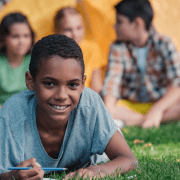Craniosacral Therapy Treatment for Autism
Richard MacDonald, DO
A mother who sought craniosacral therapy to help her son with autism shared her experience with ACN Latitudes. We asked the practicing physician, Dr. Richard MacDonald, to give us more information on the approach he used.
Mother of Zachary
I often recommend craniosacral therapy to parents of autistic youngsters. We tried many approaches, and while they all had value, this provided the greatest breakthrough for our son. Zachary is our third child, and had been a normal, responsive baby. After his first DPT and polio vaccines, he had a series of seizures. The doctor told us not to worry, that it was a reaction to the pertussis in the DPT, and a follow-up inoculation with just diphtheria, tetanus, and polio would be safe. We were nervous about it but followed the doctor’s instructions, getting the second dose at 8 months. For 24 hours afterwards, Zachary slept; then when he awoke, we realized he was not focusing as he used to and he didn’t respond to sound. We took him to the doctor; after evaluating Zachary he informed us that we had probably just never noticed our son was deaf!
We were devastated by the change in Zachary. He no longer recognized family members, could not swallow food as he used to, did not track things visually, could no longer hold an item in each hand, and ignored sounds. A test later confirmed that Zachary could hear, but he was not processing the information. A psychologist gave the diagnosis of “severely autistic.”
I went on the internet and learned about approaches including dimethylglycine, vitamin B6, and body brushing. These clearly helped Zachary over the next year, but we were still desperate when we went to Dr. Richard MacDonald for craniosacral treatments.
At the first session Zachary was crying and kicking, and we had to hold him on the treatment table. (We were used to this-we had to restrain him everyday just to get his clothes and shoes on!) At first we were concerned that Zachary was being hurt, but we soon realized that the treatments were very gentle in nature. Amazingly, about halfway through the session, Zachary lay still and started to “coo.” At the end of the treatment, he sat up and let us put his shoes on. He has never needed to be restrained since.
The changes after each successive treatment were obvious. It is my impression that this type of cranial therapy provides a release in the brain area that can be beneficial to many autistic children. We have had treatments every 3 or 4 weeks for the past 1½ years. He is also on nutritional therapy.
Zachary is now 3½. He was recently evaluated by a psychologist and is no longer considered autistic. Though he receives language therapy, he has no other delays. Zachary responds emotionally and physically like a normal child! We are grateful for our good fortune.
Dr. Richard MacDonald
I have specialized in osteopathic manipulative management for 33 years and have worked with autistic children and their families during the last 10 years.
Symptoms of autism can emerge from multiple sources: overt dysfunction in the central nervous system, food and/or chemical intolerance, biochemical deficiencies, depressed or faulty immune system responses, external influences such as DPT immunizations, and cranialsacral dysfunctions.
A multi-therapeutic program seems to be most beneficial for these youngsters and can include:
- Behavioral retraining/modification
- Craniosacral therapy and SomatoEmotional Release as developed by John Upledger, DO; Cranial Osteopathy
- Diagnosis and treatment of food, chemical and environmental intolerance
- Biochemical rebalancing through vitamin and other nutrient supplements, homeopathic medicine, and/or Chinese herbs
- Speech/language therapy as warranted
- Consistent love and affection from families and caretakers
My expertise is in the craniosacral field. Our approach involves a 20-40 minute, multi-hands-on interaction, with one or more experienced assistants. We look at our interaction with the child as that of a helper, assistant, or facilitator in the child’s healing process.
The most common somatic dysfunctions that we work with are: lumbosacral compression, occipito atlantal compression, frontal compression, and sphenobasilar compression. Medial compression of the bilateral temporal bones is also a common finding. The most consistent finding is the contraction of the cranial membrane system. Release of that membrane contraction is the key to beginning a therapeutic response.
The emotional response of the child during treatment needs to be monitored, and experience plays an important role here. The child is not asked to control their reactions in any way, nor does the therapist seek to distract the child from the reaction. Therapists who can provide an energy of unconditional love typically find sessions result in more favorable and rapid response.
We see a reduction in fear expressed by the child during the course of treatment; this is generally followed by an increase in affection and a decrease in destructive behavior. The treatments appear to generate an integrated response from the central nervous system, the endocrine system, and the autonomic nervous system. Having the opportunity to witness changes in autistic children such as Zachary has been a privileged experience.
2013 Update: Dr. Richard MacDonald has retired; More information on craniosacral therapy here.









